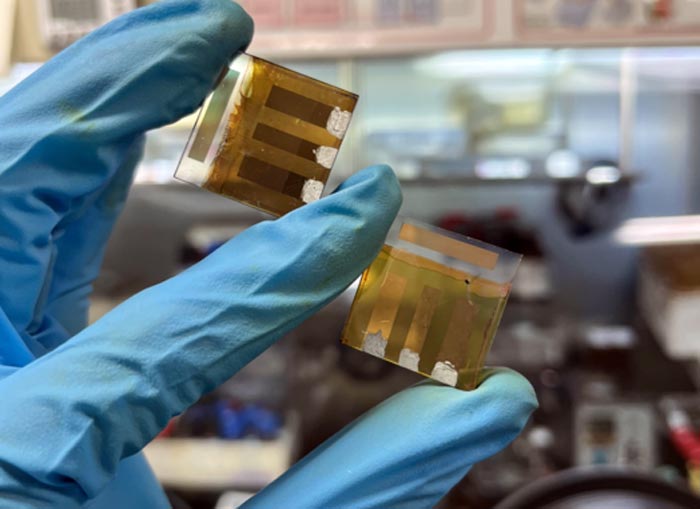Seeing photovoltaic devices in a new light

Photograph of SbSI and SbSI:Sb2S3 photovoltaic devices.
Credit: Ryosuke Nishikubo
Researchers at Osaka University measured the photovoltaic properties of antimony sulfiodide:sulfide devices and discover a voltage that depends on the wavelength of incident light, which may help develop new light-sensing and imaging devices.
Scientists from the Institute for Open and Transdisciplinary Research Initiatives at Osaka University discovered a new feature of solar cells made from antimony sulfiodide:sulfide composite they termed the wavelength-dependent photovoltaic effect (WDPE). The team determined that changing the color of incident light from visible to ultraviolet induced a reversible change in the output voltage, while leaving the current generated unchanged. This work may lead to new functional light-sensing and imaging devices.
Photovoltaic (PV) devices — such as solar cells and photodiodes — which convert light energy into electronic power are important as renewable energy sources or as light/image sensors. Recent progress in thin film PV devices has attracted much attention owing to their low-cost process, flexibility, and light weight. However, although various PV devices have been reported so far, reversible and fast wavelength-dependent responses have not been previously observed. To distinguish between irradiation colors using a single photodiode, a liquid crystal filter must be used that can electronically switch the absorption color range. However, these filters are bulky; being able to perform color detection without requiring such filters would be useful for minimizing the size of photovoltaic devices.
Now, a team of researchers at Osaka University have built new photovoltaic devices made from antimony sulfiodide:sulfide composite and found a novel effect. The voltage generated could be changed by switching the light color, in which ultraviolet reduced the output voltage. That is, a reversible change in the current versus voltage curves could be obtained simply by shining different colors of light on the device. “Such a dramatic shift in voltage is not observed in silicon, perovskites, or organic solar cells,” explains first author Ryosuke Nishikubo.
To better understand the mechanism behind this effect, the scientists then performed transient photovoltage (TPV) and photo-induced charge extraction by linearly increasing voltage (photo-CELIV). These experiments helped clarify the dramatic and reversible change in charge carrier lifetime induced by ultraviolet irradiation. The team concluded that WDPE was caused by metastable “trap” states at the heterojunction interface, generated by high energy charges. These interfacial energy traps significantly reduced output voltage, and as a result, light of certain energies could be distinguished based on the voltage. This change could be enhanced by the presence of the vapor from a polar solvent. “While our work helps advance basic science by explaining this novel effect, the research also has many potential applications, including as a vapor detector,” says senior author Akinori Saeki.
The newly discovered phenomenon may be applied to light sensing used in everything from mobile phones to cars, to security or horticultural systems. It can also be a part of imaging applications in medical and other scientific pursuits, such as space satellites and microphotography. In addition, it is also potentially desirable as a renewable energy source, because of its low toxicity and low production cost.
The article, “Unprecedented wavelength dependence of an antimony chalcohalide photovoltaic device,” was published in Advanced Functional Materials at DOI: https://doi.org/10.1002/adfm.202201577
About Osaka University
Osaka University was founded in 1931 as one of the seven imperial universities of Japan and is now one of Japan’s leading comprehensive universities with a broad disciplinary spectrum. This strength is coupled with a singular drive for innovation that extends throughout the scientific process, from fundamental research to the creation of applied technology with positive economic impacts. Its commitment to innovation has been recognized in Japan and around the world, being named Japan’s most innovative university in 2015 (Reuters 2015 Top 100) and one of the most innovative institutions in the world in 2017 (Innovative Universities and the Nature Index Innovation 2017). Now, Osaka University is leveraging its role as a Designated National University Corporation selected by the Ministry of Education, Culture, Sports, Science and Technology to contribute to innovation for human welfare, sustainable development of society, and social transformation.
Website: https://resou.osaka-u.ac.jp/en
Journal: Advanced Functional Materials
DOI: 10.1002/adfm.202201577
Method of Research: Experimental study
Subject of Research: Not applicable
Article Title: Unprecedented wavelength dependence of an antimony chalcohalide photovoltaic device
Article Publication Date: 28-Jun-2022
Media Contact
Saori Obayashi
Osaka University
gi-strategy@cgin.osaka-u.ac.jp
Office: 81-661-055-886
Original Source
All latest news from the category: Interdisciplinary Research
News and developments from the field of interdisciplinary research.
Among other topics, you can find stimulating reports and articles related to microsystems, emotions research, futures research and stratospheric research.
Newest articles

NASA: Mystery of life’s handedness deepens
The mystery of why life uses molecules with specific orientations has deepened with a NASA-funded discovery that RNA — a key molecule thought to have potentially held the instructions for…

What are the effects of historic lithium mining on water quality?
Study reveals low levels of common contaminants but high levels of other elements in waters associated with an abandoned lithium mine. Lithium ore and mining waste from a historic lithium…

Quantum-inspired design boosts efficiency of heat-to-electricity conversion
Rice engineers take unconventional route to improving thermophotovoltaic systems. Researchers at Rice University have found a new way to improve a key element of thermophotovoltaic (TPV) systems, which convert heat…



